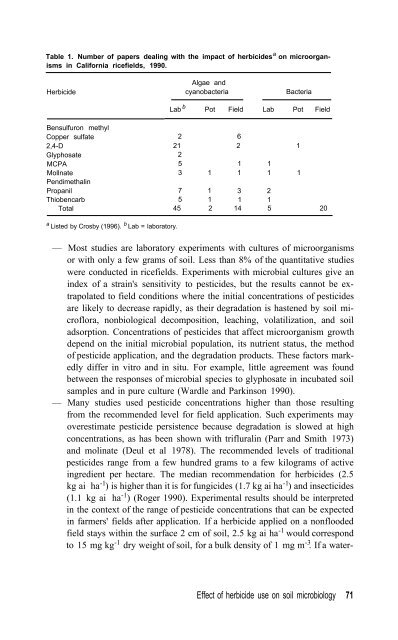HERBICIDES in Asian rice - IRRI books - International Rice ...
HERBICIDES in Asian rice - IRRI books - International Rice ...
HERBICIDES in Asian rice - IRRI books - International Rice ...
Create successful ePaper yourself
Turn your PDF publications into a flip-book with our unique Google optimized e-Paper software.
Table 1. Number of papers deal<strong>in</strong>g with the impact of herbicides a on microorganisms<br />
<strong>in</strong> California <strong>rice</strong>fields, 1990.<br />
Herbicide<br />
Algae and<br />
cyanobacteria<br />
Bacteria<br />
Lab b Pot Field Lab Pot Field<br />
Bensulfuron methyl<br />
Copper sulfate<br />
2,4-D<br />
Glyphosate<br />
MCPA<br />
Mollnate<br />
Pendimethal<strong>in</strong><br />
Propanil<br />
Thiobencarb<br />
Total<br />
2 6<br />
21 2 1<br />
2<br />
5 1 1<br />
3 1 1 1 1<br />
7 1 3 2<br />
5 1 1 1<br />
45 2 14 5 20<br />
a Listed by Crosby (1996).<br />
b Lab = laboratory.<br />
— Most studies are laboratory experiments with cultures of microorganisms<br />
or with only a few grams of soil. Less than 8% of the quantitative studies<br />
were conducted <strong>in</strong> <strong>rice</strong>fields. Experiments with microbial cultures give an<br />
<strong>in</strong>dex of a stra<strong>in</strong>'s sensitivity to pesticides, but the results cannot be extrapolated<br />
to field conditions where the <strong>in</strong>itial concentrations of pesticides<br />
are likely to decrease rapidly, as their degradation is hastened by soil microflora,<br />
nonbiological decomposition, leach<strong>in</strong>g, volatilization, and soil<br />
adsorption. Concentrations of pesticides that affect microorganism growth<br />
depend on the <strong>in</strong>itial microbial population, its nutrient status, the method<br />
of pesticide application, and the degradation products. These factors markedly<br />
differ <strong>in</strong> vitro and <strong>in</strong> situ. For example, little agreement was found<br />
between the responses of microbial species to glyphosate <strong>in</strong> <strong>in</strong>cubated soil<br />
samples and <strong>in</strong> pure culture (Wardle and Park<strong>in</strong>son 1990).<br />
— Many studies used pesticide concentrations higher than those result<strong>in</strong>g<br />
from the recommended level for field application. Such experiments may<br />
overestimate pesticide persistence because degradation is slowed at high<br />
concentrations, as has been shown with triflural<strong>in</strong> (Parr and Smith 1973)<br />
and mol<strong>in</strong>ate (Deul et al 1978). The recommended levels of traditional<br />
pesticides range from a few hundred grams to a few kilograms of active<br />
<strong>in</strong>gredient per hectare. The median recommendation for herbicides (2.5<br />
kg ai ha -1 ) is higher than it is for fungicides (1.7 kg ai ha -1 ) and <strong>in</strong>secticides<br />
(1.1 kg ai ha -1 ) (Roger 1990). Experimental results should be <strong>in</strong>terpreted<br />
<strong>in</strong> the context of the range of pesticide concentrations that can be expected<br />
<strong>in</strong> farmers' fields after application. If a herbicide applied on a nonflooded<br />
field stays with<strong>in</strong> the surface 2 cm of soil, 2.5 kg ai ha -1 would correspond<br />
to 15 mg kg -1 dry weight of soil, for a bulk density of 1 mg m -3 . If a water-<br />
Effect of herbicide use on soil microbiology 71

















